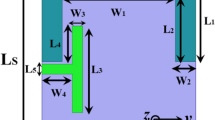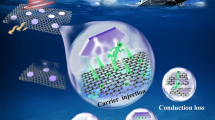Abstract
In this paper, a tunable high-gain graphene-based terahertz (THz) patch antenna is implemented and numerically studied. The antenna contains a graphene patch on top of a silicon dioxide substrate with a bottom ground plane made of gold. The designed graphene antenna operates in the fundamental \({\mathrm{TM}}_{10}\) mode at a resonant frequency of 0.61 THz. A single-element graphene patch antenna provides the boresight radiation pattern with a gain of 1.57 dBi, and a radiation efficiency of 32%. A double split ring resonator-shaped frequency selective surface (FSS) is designed and numerically studied to improve the gain of the graphene patch antenna. The FSS loaded at the top of the antenna formed a Fabry–Perot cavity. The antenna with superstrate improves the gain from 1.57 to 4.87 dBi and radiation efficiency from 32 to 55%. It is observed that the FSS enhanced the gain of the antenna around 3.3 dBi and improved the radiation efficiency around 23%. The three different sizes of patch antenna sub-arrays \(2\times 2\), \( 4\times 4\), and \(8\times 8\) are implemented and numerically studied. The sub-arrays can be used for implementing THz massive multi-input-multi-output (MIMO) applications. The sub-array enhances the gain and it also provides flexibility in the design of the beamforming massive MIMO antenna. The multibeam can be achieved by applying different phases and amplitudes to different sub-arrays. Moreover, The designed antenna response can be tuned by applying an electrostatics DC bias, which alters the surface conductivity of the graphene patch and the tunability in the antenna response achieved. The tuning frequency range of the designed graphene patch antenna around 0.5–0.65 THz. The advantage of the THz antenna provides high-speed communication, greater bandwidth, non-ionizing signal nature and compactness.















Similar content being viewed by others
Data availability
No datasets is used in the present study.
References
Akyildiz, I.F., Jornet, J.M., Han, C.: Terahertz band: next frontier for wireless communications. Phys. Commun. 12, 16–32 (2014). https://doi.org/10.1016/j.phycom.2014.01.006
Ali, M.F., Bhattacharya, R., Varshney, G.: Graphene-based tunable terahertz self-diplexing/MIMO-STAR antenna with pattern diversity. Nano Commun. Netw. 30(100378), 1–10 (2021). https://doi.org/10.1016/j.nancom.2021.100378
Ali, M.F., Bhattacharya, R., Varshney, G.: Tunable four-port MIMO / self-multiplexing THz graphene patch antenna with high isolation. Opt. Quantum Electron. 54(12), 822 (2022a). https://doi.org/10.1007/s11082-022-04200-x
Ali, M.F., Jiya, T., Singh, K.R., Varshney, G.: Terahertz antenna with controllable and tunable filtering characteristics. Micro Nanostruct. 174, 207426 (2023). https://doi.org/10.1016/j.micrna.2022.207476
Alibakhshikenari, M., Virdee, B.S., See, C.H., Abd-Alhameed, R.A., Falcone, F., Limiti, E.: Surface wave reduction in antenna arrays using metasurface inclusion for MIMO and SAR systems. Radio Sci. 54(11), 1067–1075 (2019b). https://doi.org/10.1029/2019RS006871
Alibakhshikenari, M., et al.: Study on improvement of the performance parameters of a novel 0.41–0.47 THz on-chip antenna based on metasurface concept realized on 50 μm GaAs-layer. Sci. Rep. 10(1), 1–9 (2020a). https://doi.org/10.1038/s41598-020-68105-z
Alibakhshikenari, M., Virdee, B.S., See, C.H., Abd-Alhameed, R.A., Falcone, F., Limiti, E.: High-gain metasurface in polyimide on-chip antenna based on CRLH-TL for sub-terahertz integrated circuits. Sci. Rep. 10(1), 1–9 (2020b). https://doi.org/10.1038/s41598-020-61099-8
Alibakhshikenari, M., et al.: High performance metasurface-based on-chip antenna for terahertz integrated circuits. In: 2020c 3rd International Workshop on Mobile Terahertz Systems IWMTS 2020c pp. 4–7, (2020c). doi: https://doi.org/10.1109/IWMTS49292.2020.9166324
Alibakhshikenari, M., et al.: A comprehensive survey on ‘various decoupling mechanisms with focus on metamaterial and metasurface principles applicable to SAR and MIMO antenna systems.’ IEEE Access 8, 192965–193004 (2020d). https://doi.org/10.1109/ACCESS.2020.3032826
Alibakhshikenari, M., et al.: Isolation enhancement of densely packed array antennas with periodic MTM-photonic bandgap for SAR and MIMO systems. IET Microw. Antennas Propag. 14(3), 183–188 (2020e). https://doi.org/10.1049/iet-map.2019.0362
Alibakhshikenari, M., Virdee, B.S., Limiti, E.: Study on isolation and radiation behaviours of a 34×34 array-antennas based on SIW and metasurface properties for applications in terahertz band over 125–300 GHz. Optik 206, 163222 (2020). https://doi.org/10.1016/j.ijleo.2019.163222
Alibakhshikenari, M., et al.: Study on on-chip antenna design based on metamaterial-inspired and substrate-integrated waveguide properties for millimetre-wave and THz integrated-circuit applications. J. Infrared Millim. Terahertz Waves 42(1), 17–28 (2021a). https://doi.org/10.1007/s10762-020-00753-8
Alibakhshikenari, M., Virdee, B.S., Althuwayb, A.A., Mariyanayagam, D., Limiti, E.: Compact and low-profile on-chip antenna using underside electromagnetic coupling mechanism for terahertz front-end transceivers. Electronics 10(11), 1264 (2021b). doi: https://doi.org/10.3390/electronics10111264
Alibakhshikenari, M., et al.: High-isolation antenna array using SIW and realized with a graphene layer for sub-terahertz wireless applications. Sci. Rep. 11(1), 1–14 (2021c). https://doi.org/10.1038/s41598-021-87712-y
Alibakhshikenari, M., et al.: A comprehensive survey on antennas on-chip based on metamaterial, metasurface, and substrate integrated waveguide principles for millimeter-waves and terahertz integrated circuits and systems. IEEE Access 10, 3668–3692 (2022). https://doi.org/10.1109/ACCESS.2021.3140156
Althuwayb, A.A., Alibakhshikenari, M., Virdee, B.S., Benetatos, H., Falcone, F., Limiti, E.: Antenna on chip (Aoc) design using metasurface and siw technologies for thz wireless applications. Electronics 10(9), 1–8 (2021). https://doi.org/10.3390/electronics10091120
Amanatiadis, S.A., Karamanos, T.D., Kantartzis, N.V.: Radiation efficiency enhancement of graphene THz antennas utilizing metamaterial substrates. IEEE Antennas Wirel. Propag. Lett. 16, 2054–2057 (2017)
Babu, K.V., Das, S., Sree, G.N.J., Madhav, B.T.P., Patel, S.K.K., Parmar, J.: Design and optimization of micro-sized wideband fractal MIMO antenna based on characteristic analysis of graphene for terahertz applications. Opt. Quantum Electron. 54(5), 1–20 (2022). https://doi.org/10.1007/s11082-022-03671-2
Das, P., Varshney, G.: Analysis of tunable THz antennas integrated with polarization insensitive frequency selective surfaces. Opt. Quantum Electron. 53(11), 645 (2021). https://doi.org/10.1007/s11082-021-03320-0
Das, P., Varshney, G.: Gain enhancement of dual-band terahertz antenna using reflection-based frequency selective surfaces. Opt. Quantum Electron. 54(3), 1 23 (2022). https://doi.org/10.1007/s11082-022-03548-4
Das, S., Mitra, D., Bhadra Chaudhuri, S.R.: Fractal loaded planar Super Wide Band four element MIMO antenna for THz applications. Nano Commun. Netw. 30, 100374 (2021). https://doi.org/10.1016/j.nancom.2021.100374
Das, P., Singh, A.K., Mandal, K.: Metamaterial loaded highly isolated tunable polarisation diversity MIMO antennas for THz applications. Opt. Quantum Electron. 54(4), 1–19 (2022). https://doi.org/10.1007/s11082-022-03641-8
Dmitriev, V., Rodrigues, N.R.N.M., de Oliveira, R.M.S., Paiva, R.R.: Graphene rectangular loop antenna for terahertz communications. IEEE Trans. Antennas Propag. 69(6), 3063–3073 (2020). https://doi.org/10.1109/tap.2020.3030991
Elbir, A.M., Member, S., Mishra, K.V., Member, S.: Terahertz-band joint ultra-massive MIMO model-free hybrid beamforming. IEEE J. Sel. Top. Signal Process. 15(6), 1468–1483 (2021)
Esfandiyari, M., Jarchi, S., Ghaffari-Miab, M.: Channel capacity enhancement by adjustable graphene-based MIMO antenna in THz band. Opt. Quantum Electron. 51(5), 137 (2019). https://doi.org/10.1007/s11082-019-1856-2
Jamshed Ali, M., et al.: Antenna selection and designing for THz applications: suitability and performance evaluation: a survey. IEEE Access. 8, 113246–113261 (2020). https://doi.org/10.1109/ACCESS.2020.3002989
Kiani, N., Hamedani, F.T., Rezaei, P.: Polarization controlling plan in graphene-based reconfigurable microstrip patch antenna. Opt. Int. J. Light Electron Opt. 244, 167595 (2021). https://doi.org/10.1016/j.ijleo.2021.167595
Kiani, N., Tavakkol Hamedani, F., Rezaei, P.: Realization of polarization adjusting in reconfigurable graphene-based microstrip antenna by adding leaf-shaped patch. Micro Nanostruct. 168, 207322 (2022a). https://doi.org/10.1016/j.micrna.2022.207322
Kiani, N., Tavakol Hamedani, F., Rezaei, P.: Implementation of a reconfigurable miniaturized graphene-based SIW antenna for THz applications. Micro Nanostruct. 169, 207365 (2022b). https://doi.org/10.1016/j.micrna.2022.207365
Kiani, N., Tavakkol Hamedani, F., Rezaei, P.: Reconfigurable graphene-gold-based microstrip patch antenna: RHCP to LHCP. Micro Nanostruct. 175, 207509 (2023). https://doi.org/10.1016/j.micrna.2023.207509
Kumar, A., Nagendra, V., Debabrata, P.P.: Low-profile frequency reconfigurable graphene‑based dipole antennas loaded with wideband metasurface for THz applications. Plasmonics 2351–2363 (2022). doi: https://doi.org/10.1007/s11468-022-01720-w
Li, J., He, M., Wu, C., Zhang, C.: Radiation-pattern-reconfigurable graphene leaky-wave antenna at terahertz band based on dielectric grating structure. IEEE Antennas Wirel. Propag. Lett. 16(4), 1771–1775 (2017)
Lucido, M., Balaban, M.V., Nosich, A.I.: Terahertz-range plasmon and whispering gallery mode resonances in the plane wave scattering from thin microsize dielectric disk with graphene covers. Proc. R. Soc. A Math. Phys. Eng. Sci. 20220126, 478(2262) (2022). doi: https://doi.org/10.1098/rspa.2022.0126
Moradi, K., Karimi, P.: An enhanced gain of frequency and polarization reconfigurable graphene antenna in terahertz regime. AEU Int. J. Electron. Commun. 158, 154463 (2023). https://doi.org/10.1016/j.aeue.2022.154463
Ning, B., Tian, Z., Chen, Z., Han, C., Yuan, J., Li, S.: Prospective beamforming technologies for ultra-massive MIMO in terahertz communications: a tutorial (2021). Available: http://arxiv.org/abs/2107.03032
Pajewski, L., Frezza, F., Marciniak, M., Piuzzi, E., Rossi, G.V.: Experimental analysis of a directive antenna with a 3D-EBG superstrate. J. Telecommun. Inf. Technol. 3, 113–124 (2017). https://doi.org/10.26636/jtit.2017.120017
Rodrigues, N.R.N.M., de Oliveira, R., Dmitriev, V.: Smart terahertz graphene antenna: operation as an omnidirectional dipole and as a reconfigurable directive antenna. IEEE Antennas Propag. Mag. 60(5), 26–40 (2018)
Sainadh, P.M., Sharma, A., Ghosh, S.: Polarization-insensitive absorptive/transmissive reconfigurable frequency selective surface with embedded biasing. IEEE Antennas Wirel. Propag. Lett. 22(1), 1–5 (2022). doi: https://doi.org/10.1109/lawp.2022.3206098
Siddiqui, J.Y., Saha, C., Antar, Y.M.M.: Compact dual-SRR-loaded UWB monopole antenna with dual frequency and wideband notch characteristics. IEEE Antennas Wirel. Propag. Lett. 14, 100–103 (2015). https://doi.org/10.1109/LAWP.2014.2356135
Singh, R., Varshney, G.: Isolation enhancement technique in a dual-band THz MIMO antenna with single radiator. Opt. Quantum Electron. 55(6), 1–17 (2023). https://doi.org/10.1007/s11082-023-04811-y
Singh, A., Andrello, M., Thawdar, N., Jornet, J.M.: Design and operation of a graphene-based plasmonic nano-antenna array for communication in the terahertz band. IEEE J. Sel. Areas Commun. 38(9), 2104–2117 (2020). https://doi.org/10.1109/JSAC.2020.3000881
Singh, S.K., Amit, K., Abegaonkar, M.P., Koul, S.K.: Metamaterials for Antenna Applications. CRC Press, Boca Raton (2021)
Sirtori, C.: Bridge for the terahertz gap. Nature 417(6885), 132–133 (2002). https://doi.org/10.1038/417132b
Tamagnone, M., Perruisseau-Carrier, J.: Predicting input impedance and efficiency of graphene reconfigurable dipoles using a simple circuit model. IEEE Antennas Wirel. Propag. Lett. 13, 313–316 (2014). https://doi.org/10.1109/LAWP.2014.2305400
Tamagnone, M., Gómez-Díaz, J.S., Mosig, J.R., Perruisseau-Carrier, J.: Analysis and design of terahertz antennas based on plasmonic resonant graphene sheets. J. Appl. Phys. 112(11) (2012). doi: https://doi.org/10.1063/1.4768840
Temmar, M.N.E., Hocini, A., Khedrouche, D., Denidni, T.A.: Analysis and design of MIMO indoor communication system using terahertz patch antenna based on photonic crystal with graphene. Photonics Nanostruct. Fundam Appl. 43, 100867 (2020). https://doi.org/10.1016/j.photonics.2020.100867
Varshney, G.: Reconfigurable graphene antenna for THz applications: a mode conversion approach. Nanotechnology 31(13), 135208 (2020). https://doi.org/10.1088/1361-6528/ab60cc
Varshney, G.: Tunable terahertz dielectric resonator antenna. Silicon 13(6), 1907–1915 (2021). https://doi.org/10.1007/s12633-020-00577-0
Varshney, G., Gotra, S., Pandey, V.S., Yaduvanshi, R.S.: Proximity-coupled two-port multi-input-multi-output graphene antenna with pattern diversity for THz applications. Nano Commun. Netw. 21, 100246 (2019). https://doi.org/10.1016/j.nancom.2019.05.003
Vasu Babu, K., Das, S., Varshney, G., Sree, G.N.J., Madhav, B.T.P.: A micro-scaled graphene-based tree-shaped wideband printed MIMO antenna for terahertz applications. J. Comput. Electron. 21(1), 289–303 (2022). https://doi.org/10.1007/s10825-021-01831-3
Vijayalakshmi, K., Selvi, C.S.K., Sapna, B.: Novel tri-band series fed microstrip antenna array for THz MIMO communications. Opt. Quantum Electron. 53(7), 395 (2021). https://doi.org/10.1007/s11082-021-03065-w
You, X., Gao, H., Zhou, L., Zhao, H.: Compact dual-element inverted-F MIMO antenna system with enhanced isolation. Microw. Opt. Technol. Lett. 58(2), 363–368 (2015)
You, X., et al.: Terahertz reflectarray with enhanced bandwidth. Adv. Opt. Mater. 7(20), 1900791 (2019). https://doi.org/10.1002/adom.201900791
You, X., Ako, R.T., Bhaskaran, M., Sriram, S., Fumeaux, C., Withayachumnankul, W.: Mechanically tunable terahertz circular polarizer with versatile functions. Laser Photonics Rev 17(4) 2200305 (2023). doi: https://doi.org/10.1002/lpor.202200305
Zhang, B., Jornet, J.M., Akyildiz, I.F., Wu, Z.P.: Mutual coupling reduction for ultra-dense multi-band plasmonic nano-antenna arrays using graphene-based frequency selective surface. IEEE Access 7, 33214–33225 (2019). https://doi.org/10.1109/ACCESS.2019.2903493
Zhao, M., Juan, Z., Jianping, Xu.: Design and analysis of dual-band FSS based on equivalent circuit. Int. J. RF Microw. Comput. Aided Eng. 32(12), 23405 (2022)
Funding
No funding is received from any organization for this research work.
Author information
Authors and Affiliations
Contributions
MFA has developed the idea and implemented it and written the manuscript. RB has supervised all the work and editing aspects of the manuscript.
Corresponding author
Ethics declarations
Conflict of interest
There is no associated data with this research work.
Additional information
Publisher's Note
Springer Nature remains neutral with regard to jurisdictional claims in published maps and institutional affiliations.
Rights and permissions
Springer Nature or its licensor (e.g. a society or other partner) holds exclusive rights to this article under a publishing agreement with the author(s) or other rightsholder(s); author self-archiving of the accepted manuscript version of this article is solely governed by the terms of such publishing agreement and applicable law.
About this article
Cite this article
Ali, M.F., Bhattacharya, R. Tunable high-gain graphene patch antenna for THz massive MIMO applications using FSS. Opt Quant Electron 55, 1204 (2023). https://doi.org/10.1007/s11082-023-05326-2
Received:
Accepted:
Published:
DOI: https://doi.org/10.1007/s11082-023-05326-2




